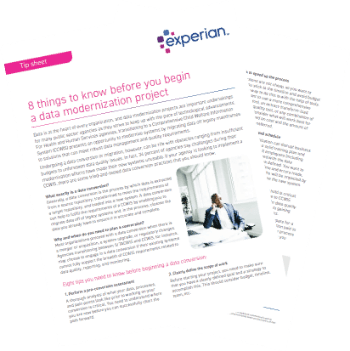- Products

Enjoy a free 30-day trial of our
data validation software.Experience the power of trusted data
solutions today, no credit card required! - Solutions

Enjoy a free 30-day trial of our
data validation software.Experience the power of trusted data
solutions today, no credit card required! - Partners

Enjoy a free 30-day trial of our
data validation software.Experience the power of trusted data
solutions today, no credit card required! - Learn more
- Pricing
- Contact Us
8 things to know before you begin a data modernization project
Data is at the heart of every organization, and data modernization projects are important undertakings for many public sector agencies as they strive to keep up with the pace of technological advancements. For Health and Human Services agencies, transitioning to a Comprehensive Child Welfare Information System (CCWIS) presents an opportunity to modernize systems by migrating data off legacy mainframes to solutions that can meet robust data management and quality requirements.
Undergoing a data conversion or migration, however, can be rife with obstacles ranging from insufficient budgets to unforeseen data quality issues. In fact, 34 percent of agencies say challenges during their modernization efforts have made their new systems unusable. If your agency is looking to implement a CCWIS, there are some tried-and-tested data conversion practices that you should know.
What exactly is a data conversion?
Generally, a data conversion is the process by which data is extracted from a source repository, transformed to meet the requirements of a target repository, and loaded into a new system. A data conversion can help to fulfill the requirements of a CCWIS by enabling you to migrate data off of legacy systems and, in the process, cleanse the data you already have to ensure it is accurate and complete.
Why and when do you need to plan a conversion?
Most organizations proceed with a data conversion when there is a merger or acquisition, a system upgrade, or regulatory changes. Agencies transitioning between S/TACWIS and CCWIS, for instance, may choose to engage in a data conversion if their existing systems cannot fully support the breadth of CCWIS requirements related to data quality, reporting, and monitoring.
1. Perform a pre-conversion assessment
A thorough analysis of what your data, processes, and pain points look like prior to working on your conversion is critical. You need to understand where you are now before you can successfully chart the path forward.
2. Clearly define the scope of work
Before starting your project, you need to make sure that you have a clearly defined goal and a strategy to accomplish this. This should consider budget, timeline, team, etc.
3. Understand of current state of data
What does your data even look like? Do you need to go through a cleansing process? You don’t want to push bad data into a new system, so you need to complete an analysis on all your databases before moving forward with a conversion.
4. Assemble the best team possible
You want to ensure that you have all stakeholders represented; this means you may need someone from each department that relies on the data. A successful team isn’t complete without a project manager. This role is critical as they will be responsible for wrangling all the stakeholders, maintaining the budget, and ensuring the timeline is enforced.
A successful team isn’t complete without a project manager. This role is critical as they will be responsible for wrangling all the stakeholders, maintaining the budget, and ensuring the timeline is enforced.
Leadership and management needs to be involved in data conversion because of how essential data is to the organization. They need to be kept in the loop, and they can act as the final decision-maker on crucial steps throughout the process.
5. Align on priorities
When it comes to any project that touches multiple departments in the organization, you can see competing priorities and lots of opinions. Before initiating any data conversion project, you want to make sure that everyone is on the same page with a clearly defined scope of work, goals and objectives, and that the project manager keeps everyone up-to-date with a solid communication plan.
6. Define a data quality management process
Most departments across your organization rely on the data that you have, and many collect and analyze pieces of information specific to their roles. You must have a clearly defined process to ensure consistency and standardization so everyone can confidently depend on your data.
7. Use tools to speed up the process
Data conversions are not cheap, so you want to make sure you stick to the timeline and avoid budget overruns. One way to do this is with the help of tools. Whether you want to use a more comprehensive data conversion tool, an extract-transform-load (ETL) tool, a data quality tool, or any combination of these, you should consider what will work best for your conversion based on cost and the amount of information being transferred.
8. Create a training plan and schedule
Anything new to an organization can disrupt business as usual. Ensure you have a solid training plan and schedule in place to bring all employees (including future newcomers) up to speed with the data management process you have defined. You want to minimize the amount of downtime and errors made, so making sure that everyone who will be impacted by the conversion is taught how to use the new system needs to be a priority.
The data that child welfare agencies hold is critical and life-changing. Ensuring adherence to CCWIS requirements by implementing the right data quality and management strategy is important to gaining clarity around cases, children, and families.
At Experian, our solutions will help you prepare for a successful data conversion with close attention paid to the quality of the information. If you are in the process of implementing a CCWIS system, we can help you check-off the list of requirements.
Talk to one of our data experts to get started on the right path.
